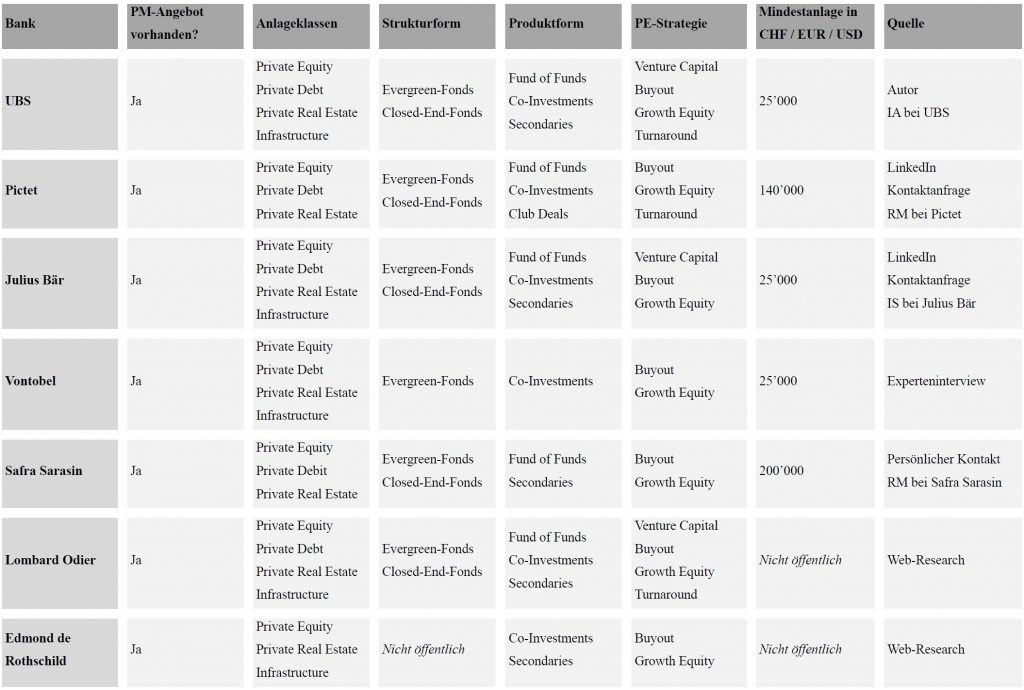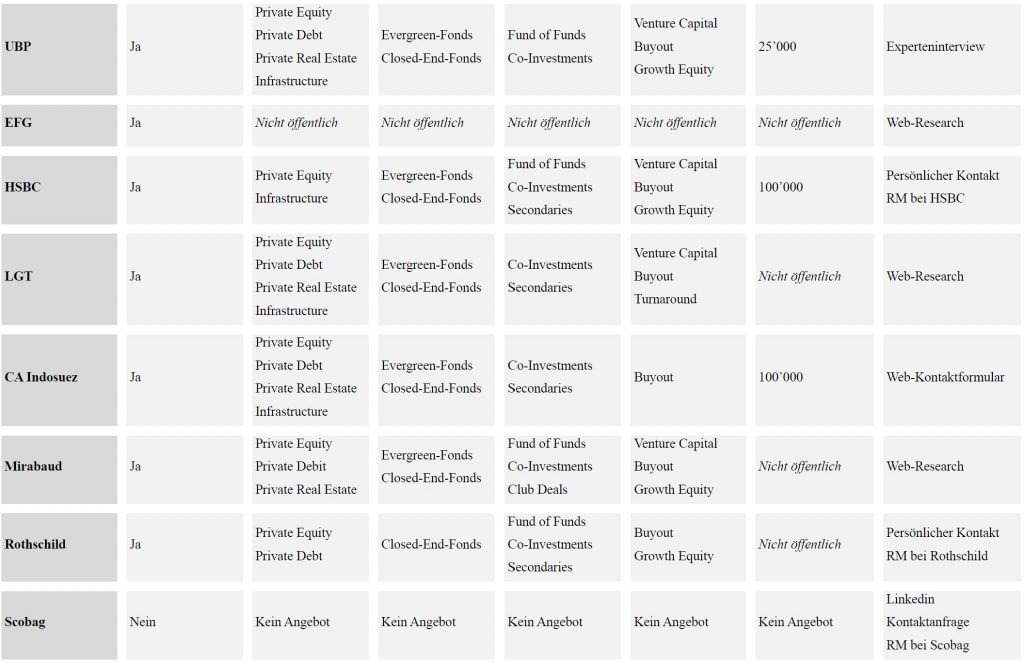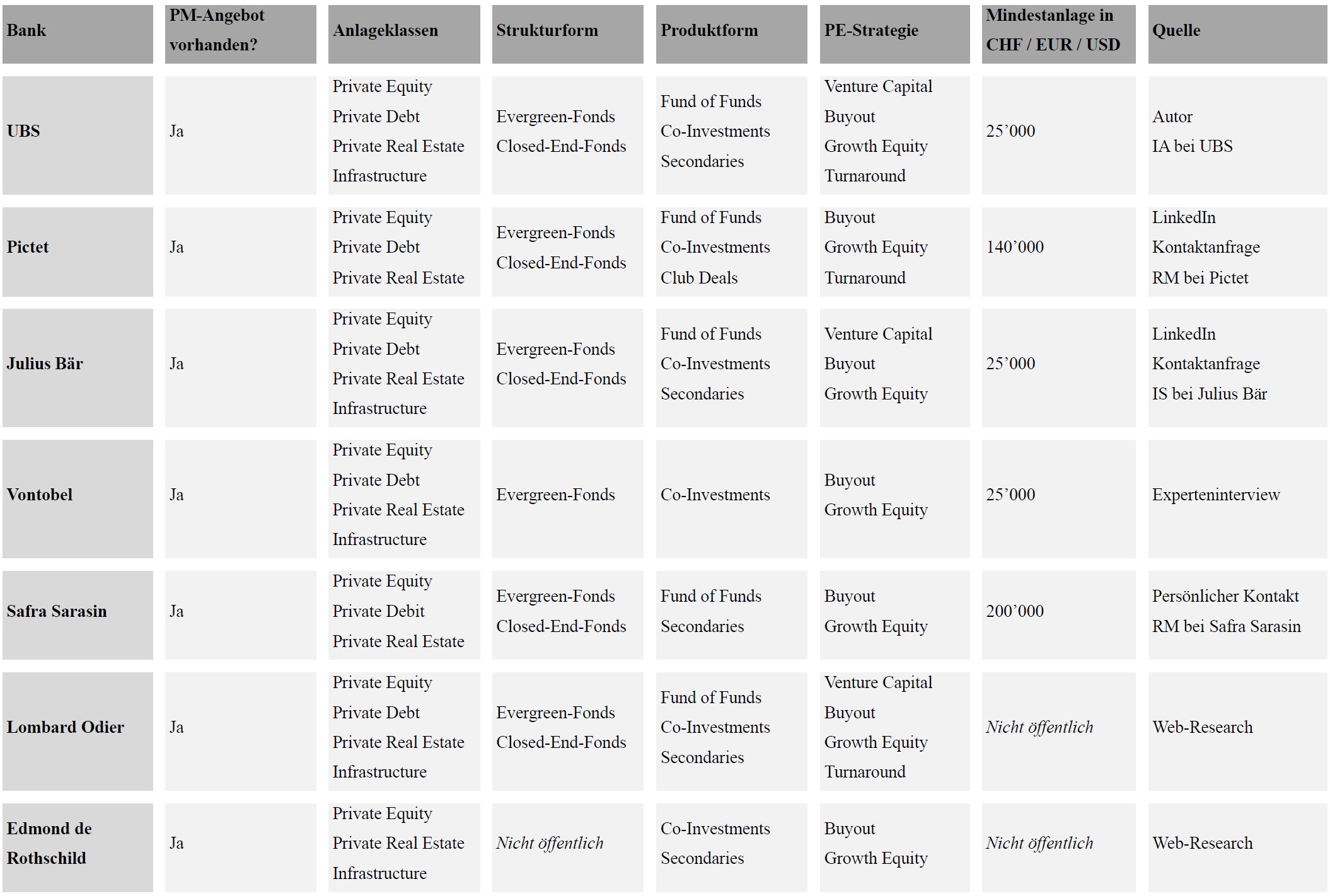Key Insights from a new Bachelor’s thesis by Subisan Suthesan
Private Markets are firmly on the strategic agenda of Swiss wealth management banks. But how exactly do banks implement their offerings for wealthy clients? Which asset classes are offered, what structures are used, and how accessible are these solutions?
These questions are addressed in a recent Bachelor’s thesis at ZHAW School of Management and Law by Subisan Suthesan, which I had the opportunity to supervise. Subisan’s work is well-researched, clearly structured, and provides practical value for anyone working in Private Markets or wealth management.
At the core of the thesis is a particularly useful summary table (see below). It consolidates the Private Markets offerings of 18 Swiss wealth management banks with over CHF 20 billion in assets under management and provides a concise comparison across asset classes, structures, access thresholds, and target clients. These banks were selected by the findings of my flagship “Wealth Management in Switzerland” research studies, which are available for free PDF download.
What Was Analyzed
Subisan’s Bachelor’s thesis covers:
- 18 Swiss wealth management banks with AUM over CHF 20 billion
- A range of Private Markets asset classes (Private Equity, Private Debt, Private Real Estate, Private Infrastructure)
- Expert interviews with senior professionals from leading institutions such as UBS, ZKB, Vontobel, or UBP
This combination of structured desktop research and qualitative insights provides a well-rounded perspective of today’s offering landscape in Switzerland.
The Private Markets Landscape – In One Table
The standout feature of the thesis is a summary matrix that presents the Private Markets offerings of each bank along the following dimensions:
- Asset Classes: Private Equity is universally offered, while Private Debt, Private Real Estate, and Private Infrastructure are less commonly available.
- Investment Structures: Closed-end funds still dominate, but feeder structures, evergreen funds, and platform-based access (e.g., via Moonfare or iCapital) are gaining traction.
- Target Segments: Nearly all banks focus on UHNWIs and family offices. Only a minority offer solutions for HNWIs or affluent clients.
- Entry Points: Minimum investments typically range from CHF 100k to CHF 250k, though a few banks allow entry from CHF 25k through digital platforms.



This summary table allows for initial visual benchmarking and helps identify where your institution stands in terms of product architecture, client focus, and structural innovation. Overall, the summary table appears to reveal a Swiss private markets landscape that is:
- Strategically relevant for most wealth management banks, but still fully segmented
- Strongly reliant on traditional fund structures, though open to innovation
- Not yet fully democratized, though digital platforms are beginning to lower barriers
- Operationally complex, requiring RM trainings, new processes, and often third-party partnerships
Trends to Watch
Based on Subisan’s thesis and supporting interviews, several trends appear to be emerging for 2025 and beyond:
- Private Equity is mature – and crowded
Swiss wealth management banks are looking to differentiate through niche strategies, lower ticket sizes, or co-investments. - New access models are evolving
Digital feeder platforms and evergreen funds offer flexibility and scale. Tokenization is still early-stage but could be a long-term enabler. - Client segmentation is key
Most solutions remain tailored for UHNWIs. Reaching broader segments will require simplified products and education (and: regulatory clarity). - Platform partnerships are shaping the market
Swiss wealth management banks increasingly act as distributors and curators rather than manufacturers – especially in private markets.
Outlook and Contacts
Private Markets are no longer niche in Swiss wealth management – but the industry still faces key decisions:
- How far down the wealth pyramid to go?
- Whether to build internal capabilities or partner with external platforms?
- How to manage illiquidity, RM and client education, and operational complexity?
The coming years may see increasing pressure to integrate private markets more deeply into standard advisory offerings, especially as clients look for diversification, yield, and differentiated returns.
If you’d like to explore the Bachelor’s thesis in more detail or discuss its findings, please reach out directly to the author, Subisan Suthesan, via LinkedIn.
Congratulations on your useful, insightful and relevant Bachelor’s thesis Subisan, well done!
